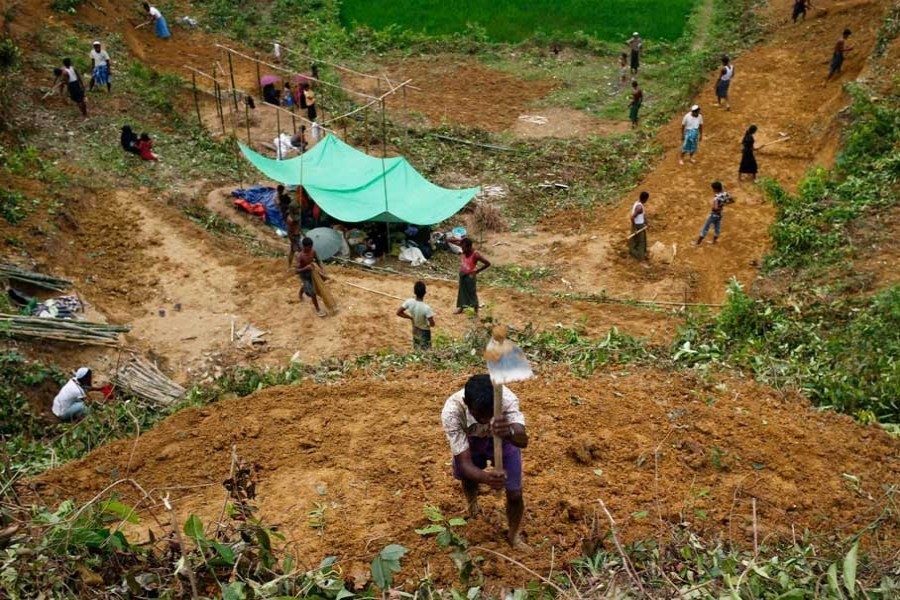Land is undeniably the foundation of the country's economic development, and it is directly linked to the gross domestic product (GDP). It is the basis upon which all economic activities take place.
An element of uncertainty looms over the future prospect of Bangladesh in as much as it relates to the resources and the needs of the citizens. Trees are being recklessly felled for fuel or for commercial purposes. Climatic disruption in recent times, followed by salinity intrusion, shrinking farmlands and crop losses, has added much to the woes of the people of the country.
What is worrying is that the country, with the world's highest density of population, is fast losing arable land due to growing industrialisation and rapid encroachment of human habitats on farming areas. Bangladesh is losing 8000 hectares of farm land every year from its original 13 million hectares of cropland due to urbanisation, industrialisation, unplanned rural housing and infrastructure building.
The country's fast growing population is now looking for new land to build homes while entrepreneurs are going to the remote areas of the countryside to set up factories. Agriculture accounts for only 21 per cent of the country's gross domestic product (GDP) although the sector employs around 50 per cent of the nation's workforce.
The World Trade Organisation (WTO) recently referred this critical issue at an international forum, pointing out that in the world's poorest corners, including Bangladesh, land is getting divided through inheritance and farm sizes are getting smaller and smaller with the passing of every generation.
There will be no cultivable land left in Bangladesh in 50 years if lands are taken away for non-farm purposes at the current rate. If the trend is not reversed now, the country would permanently lose its food security, making its poor population more vulnerable to volatile international commodity prices.
In order to reverse this trend, the government has taken some steps including banning use of arable land for purposes other than agriculture. A high-level committee suggested that the factories and educational institutions that have already been built should now go vertical, instead of grabbing more arable land. But the government is failing to monitor how much arable land is being transferred for use other than agricultural purposes due to dearth of man power.
The dwindling size of farms, rise in landlessness and constant depletion of farmland are posing formidable threats to Bangladesh's agriculture, increasing poverty and trapping the ultra-poor in a vicious circle. The average farm size has been reduced to less than 0.6 hectares and the percentage of landless people stands at 58 in a country where nearly 80 per cent of the ultra-poor live in rural areas.
Worries about farmland depletion at an alarming rate have fallen into deaf ears, while calls for ensuring optimum utilisation of arable land and bringing fallow lands under cultivation remain in rhetoric alone. Successive governments concentrated all their focus on higher production of rice, while import bills for fuel, cooking oils and pulses continued to inflate due to global price volatility in recent years.
Rice cultivation covers about 80 per cent of Bangladesh's total cultivated area. Since rice is the staple food and a politically-sensitive product, agricultural policymakers during successive regimes concentrated almost solely on rice production and cared little about other major items. Some holistic approaches were planned, but those did not get sufficient response.
An integrated crop management package may be launched by designing agricultural zones based on weather and soil conditions for increasing agricultural production. It is also worrying to find that government expenditure on agricultural research has been steadily declining in Bangladesh. Allocation for agricultural research should be raised to 2.0 per cent from 0.2 per cent of the agricultural gross domestic product (GDP) to reduce dependence on imports.
The country could easily utilise regions such as Barind tracts, coastal zone and Sylhet haors to grow more Rabi crops comprising pulses and oil seeds to significantly reduce imports. Experts suggest an integrated crop management package by designing agricultural zones based on weather and soil conditions for increasing agricultural production.
If the use of arable land for non-farming purposes is not immediately contained, the country is poised to face multiple problems arising from land scarcity and rising population. These challenges must be addressed with topmost priority.
A report on climate change says the probable loss of arable and residential lands through flooding in this part of the world (Bangladesh and its neighbourhood) would result in increase of internal and external environmental migration and strained relations among countries. A solution to the issue of farmland depletion could be formulation of a realistic land-use policy.
It is to be found out why people are becoming landless and how to solve the problem of shrinkage of arable land. Only then necessary measures can be taken. Keeping the population growth rate under control, proper steps should be taken as early as possible to ensure planned urbanisation in the country. In Bangladesh, the problem of economic development has so far been addressed mainly in isolation from the population perspective. But these are actually integral elements of a single strategy and thus need to be treated accordingly.
All said and done, the government needs to formulate a cohesive strategy for land reform. Given the complexity in the task, strong political will is needed to carry the land reform agenda forward based on strategic vision and doable implementation plans.


